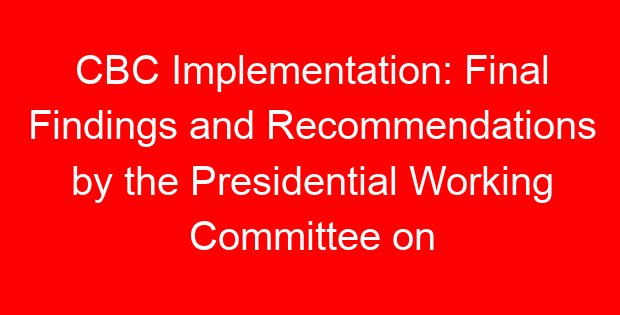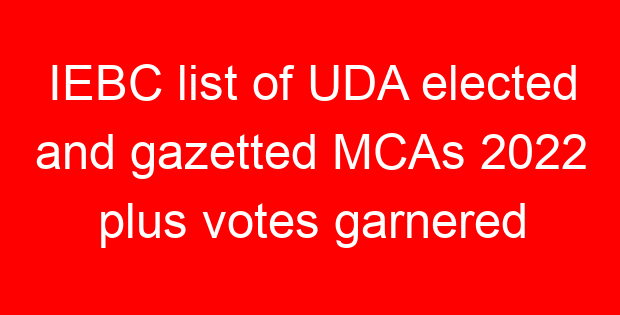CBC Implementation: Final Findings and Recommendations by the Presidential Working Committee on Edyucation
Findings on Basic Education
The PWPER commenced its work when the implementation of CBC was completing the Primary School cycle (Grade 6). The stakeholders acknowledged the value of CBC in terms of skills acquisition, collaborative action among learners, new pedagogy, linking learning to the community, and parental involvement.
However, stakeholders raised concerns on the high number of learning areas in Primary and Junior Secondary school; overloads and overlaps of the curriculum; high cost of actualizing CBC passed to parents; challenges of internet and electricity connectivity that negatively affected digital literacy; and low literacy and numeracy levels for foundational learning.
In addition, the domiciling of Junior Secondary School was raised as an issue of concern across the counties with an overwhelming majority (93%) proposing its hosting at the current Primary School. Majority of stakeholders pointed that teachers were inadequately trained on CBC; infrastructure and learning resources were inadequate; parallel roles and structures by the TSC and MoE jeopardised quality assurance and efficiency; categorisation of public Secondary schools promoted exclusion; and that key tenets guiding CBC were not fully mainstreamed in all the dimensions of learning.
Further there was inadequate sensitization of parents on their roles; teacher training for CBC implementation was inadequate, the Community Service Learning, though great in concept, its implementation remain costly and time consuming.
The findings showed that EMIS did not capture data for all school-age children, those above 18, and students in Tertiary and vocational institutions. The governance of Pre-school introduced bottlenecks with both national and county governments playing a role without a clear working framework.
The Boards of management were bloated causing a financial strain to schools. The Indigenous and Foreign languages lacked teachers and textbooks in school denying learners opportunities to pursue them.
The career pathways at Senior School was not well understood especially how learners would be placed. In general, the stakeholders opined that CBC provided learners with relevant competencies and values for life. However the challenges of implementation threatened to wipe out the gains.
Findings on Tertiary Education
Education reform at the Tertiary level is driven by national development imperatives and the demand of the socio-economic enterprises and industry.
Technical and Vocational Education and Training (TVET) has the potential to spur rapid economic growth using modern technologies; and commits the youthful population into employment that yield innovations and enterprises.
To realise the full benefits of TVETs, certain interventions need to be put in place to address the following: Lack of a clear framework and structures to operationalise partnerships and linkages between institutions and industry; recognition of prior learning to promote lifelong learning; operationalisation of credit accumulation and transfer; lack of career progression and transfer guidelines for trainees; embracing apprenticeship as part of TVET learning; and low support and involvement of Special Needs Education in TVET.
The current governance and funding arrangement of Vocational Training Centres (VTCs) impede their growth and quality of output.
Kenya has experienced phenomenal growth in University education since Independence, currently having 78 Universities. However, there are critical issues bedeviling the performance of the Universities as evidenced by low Global University rankings; low enrolment of international students; and weak structures of governance and funding.
The composition of University Councils; appointment of Chancellors, Vice-Chancellors and top management; quality of research output and innovation; and operationalisation of an Open University are critical areas of concern, if the Kenyan Universities are to remain globally competitive, and industry-responsive.
The stakeholders proposed a review of the governance structure of the student councils and welfare issues of the non-teaching staff.
It was further observed that the existence of several bodies and government agencies with overlapping mandates contributes to multiplicity of standards and qualifications leading to wastage and inefficiencies.
There exists ambiguities, inconsistencies and constraints in various legislation that create loopholes for multiple allocation of funds to the same beneficiaries at the expense of others; poor employer-employee relations; non-operationalisation of policies and guidelines; conflicts due to weak governance structures; and compromise of quality of service delivery.
The education sector does not operate in a vacuum, but is influenced by many external factors. The PWPER scanned the horizon on a raft of cross-cutting issues, pertinent and contemporary, that have potential to impact on education. The issues of climate change; appreciation and integration of indigenous knowledge; internationalisation of University education; and proper utilisation of the widening digital space must inform education reform.
There is need to curb the rising cases of teenage pregnancies; early marriages; radicalisation and extremism; drug and substance abuse; and students’ unrest and bullying. Education reform need to promote mental health; appreciation and care of the environment; inculcation of values; and preparedness in emergencies and disasters.
Conclusion and Recommendations
On the basis of these findings, the PWPER concludes that effective implementation of Competency-Based Curriculum at all levels of education provides a strong foundation for transforming education, training and research for sustainable development in Kenya. The key recommendations include:
- Ministry of Education to adopt a Comprehensive School system (PP1 — Grade 9) comprising Pre-Primary, Primary school and Junior School managed as one The term “Secondary” be dropped from the current Junior Secondary and Senior Secondary School.
- Kenya should prioritise investing in foundational learning to avert future crisis in education. Basic literacy, numeracy and transferable skills such as social, emotional skills ensures essential blocks for acquiring higher order
- Kenya Institute of Curriculum Development (KICD) to reduce the number of learning areas from 9 to 7 at Lower Primary; 12 to 8 at Upper Primary; 14 to 9 at Junior School in order to address overload and overlaps. The learning areas at Pre-Primary to be 5 and at Senior School to be
- Ministry of Education to discontinue the current categorisation of public Secondary schools as National, Extra-county, County and Sub-county; and adopt a categorization based on career pathways for Senior
- Rename Education Management Information System (EMIS) to Kenya Education Management Information System (KEMIS); and the Ministry of Education in collaboration with the Ministry of Interior and National Administration to integrate registration of births and to capture students in tertiary and vocational institutions as well as school-age learners who are out of
- The Ministry of Education to establish Kenya School of Teacher and Education Management (KeSTEM) to coordinate In-service training; and Kenya Teacher Training College (KeTTC) to undertake administration of all Pre-service Teacher
- To resolve overlapping mandate in Quality Assurance and Standards function in Basic Education, transfer the Quality Assurance and Standards functions at TSC to the Ministry of Education. In addition strengthen the Directorate of Quality Assurance and Standards at the State Department of Basic Education.
- In order to attract, develop and retain effective teachers, there be a one-year mandatory retooling program for all graduates of pre-service training to be CBC- compliant; and a one-year mandatory internship program upon completion of pre-service training before being registered into the teaching
- Implement a minimum essential package to cushion schools with enrolment below the optimum level. The recommended amounts are Ksh. 70,200 for Pre- Primary; Ksh. 537,120 for Primary level; Ksh. 2,030,805 for Junior School; Ksh. 3,041,145 for Senior School; and Ksh. 1,890,000 for Special Needs Education.
- Implement revised capitation in view of the realities of CBC as follows: Ksh 1,170 for Pre-Primary; 2,238 for Primary level; Ksh. 15,043 for Junior School; Ksh. 22,527 for Senior School (Day); Ksh. 19,800 for SNE (Day) and Ksh. 38,280 for SNE (Boarding); and consider increasing the grant for ACE. The capitation and grants to be reviewed every three years.
- Coordinate the management of bursaries and scholarships under the Kenya Basic Education Bursaries and Scholarship Council as a successor to the Jomo Kenyatta
- The Ministry of Education to develop guidelines for accelerated education programs for marginalised groups, learners with special needs and adult and continuing education, to enhance equitable access and
- Institutionalise linkages of TVETs with industries and government projects; and develop pathways for continuity between TVET and Universities and vice
- Adopt a sustainable financing model for University education that combines grants/scholarship, loans and household contributions for differentiated categories of students as vulnerable, extremely needy, needy and less needy in order to address equitable access and inclusion in
- Enact the proposed Tertiary Education Placement and Funding Bill to amalgamate HELB, UFB and TVET Fund to enhance efficiency in higher education funding.
- National Government and County Governments to develop a financing framework for ring-fencing resources for
- The Government to operationalise the Open University in Kenya with the first cohort of students being admitted in September,
- To strengthen governance of the University sector, undertake amendments to the Universities Act to amongst others, exclude Public Service Commission (PSC) in the appointment process of Chancellors, provide for a selection panel in the appointment of Chancellors and Council members, and empower Councils to be responsible for appointment of Vice-Chancellors and other top management of
- Institutionalise environmental conservation and climate change action in all learning
- Introduce a mandatory three (3) months community service programme for graduates of Senior School before joining Tertiary institutions and a further nine (9) months of mandatory community service after completion of Tertiary education. A certificate of compliance to the community service to be issued as proof before admission into the world of work.
- Government of Kenya to develop internal capacity of KNEC to print national
The rest of the recommendations are contained at the end of each chapter.
In order to effectively implement the recommendations in this Report, it is recommended that there be established a Committee to be known as Ministerial Education Reform Implementation Advisory Committee (MERIAC). The membership of the committee shall include representation from the PWPER to provide institutional memory. The mandate of the committee shall be spelt out by the Cabinet Secretary, Ministry of Education.




